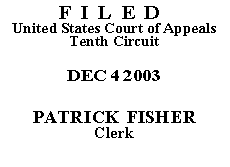

| UNITED STATES OF AMERICA,
Plaintiff-Appellee, v. JOSEPH B. KELSEY, Defendant-Appellant. |
|
§ 1291 and 18 U.S.C. § 3145(c), and we affirm.
Mr. Kelsey is charged in an indictment with violating 21 U.S.C. § 841(a)(1) and § 841(b)(1)(b) of the Controlled Substances Act by possessing five grams or more of methamphetamine with intent to distribute, and with violating 18 U.S.C. § 922(g)(1) by being a felon in possession of a firearm and ammunition. He has been detained since April 2003.
"Under the Bail Reform Act, a defendant may be detained pending trial only if a judicial officer finds 'that no condition or combination of conditions will reasonably assure the appearance of the person as required and the safety of any other person and the community.' 18 U.S.C. § 3142(e); id. § 3142(b),(c)." United States v. Cisneros, 328 F.3d 610, 616 (10th Cir. 2003). The government "must prove dangerousness to any other person or to the community by clear and convincing evidence." Id. Danger to the community encompasses the danger that a defendant will continue to engage in felony drug trafficking activity. United States v. Cook, 880 F.2d 1158, 1161 (10th Cir. 1989).
In June 2003, a magistrate judge denied Mr. Kelsey's request for release on bail after conducting a detention hearing. Mr. Kelsey appealed to the district court, which redetermined the issue de novo after holding another bail hearing on August 13. See 18 U.S.C. § 3145(b); Cisneros, 328 F.3d at 616 n.1. At the hearing, the United States presented evidence that (1) Mr. Kelsey had a 1992 felony conviction for using or carrying a firearm during a drug trafficking crime;(1) (2) in February 2003, he was arrested while in possession of approximately 24.7 grams of methamphetamine packaged in fourteen baggies, packaging materials, scales, and $744 in cash, resulting in a felony drug-trafficking indictment; and a handgun was found under the seat of the car in which he arrived immediately before his arrest; (3) he was released on bail; (4) in April 2003 he was again arrested in possession of a baggie containing methamphetamine; marijuana and a marijuana pipe were discovered in a drawer in his bedroom; and a box for the same make, model, and serial number of the firearm confiscated during his February arrest was discovered in his bedroom closet; and (5) a blood sample taken after his February arrest demonstrated a toxic level of methamphetamine in Mr. Kelsey's blood. The government argued that this evidence supported a conclusion that Mr. Kelsey could not stay away from drugs and that he was a danger to the community.
Mr. Kelsey presented four witnesses who testified that they had never seen him use or possess drugs; that they did not consider him a danger to the community; that his mother was willing to allow him to move in with her so she could "keep an eye on him," App. Ex. 15 at 30; and that he is a self-employed, successful, and conscientious carpenter with strong family ties to the community. Counsel for Mr. Kelsey argued that all evidence procured in the February and April arrests should be excluded under the Fourth Amendment and that the pretrial services report stated that, based on his prior criminal record, Mr. Kelsey was "a manageable risk of danger to the community . . . ." Id. Ex. 3 at 3.
After reviewing the evidence in light of the requirements found in
§ 3142(g), the district court concluded that the government had shown by clear and convincing evidence that no conditions of release existed that would reasonably assure the safety of other persons or the community. The court also concluded that "the fact that Defendant appears to have been able to hide his apparent drug activities from those close to him makes him a danger to society." App. Ex. 17 at 2-3. The district court denied the appeal of the magistrate judge's detention order and ordered continuing detention.
"We apply de novo review to mixed questions of law and fact concerning the detention or release decision, but we accept the district court's findings of historical fact which support that decision unless they are clearly erroneous." Cisneros, 328 F.3d at 613. We conclude that the government provided clear and convincing evidence that Mr. Kelsey has demonstrated an inability to stay away from drugs and drug-related activity, thereby making him a danger to society. The district court's finding that Mr. Kelsey's proven ability to hide his drug activity from his closest friends and family members makes it unlikely that his mother's supervision could reduce the risk that he would continue to possess or to distribute drugs in the community if released on bail is not clearly erroneous. Because the government satisfied its statutory burden to support continued detention, we AFFIRM.
ENTERED FOR THE COURT
PER CURIAM
*. This order and judgment is not binding precedent, except under the doctrines of law of the case, res judicata, and collateral estoppel. The court generally disfavors the citation of orders and judgments; nevertheless, an order and judgment may be cited under the terms and conditions of 10th Cir. R. 36.3.
1. In the early 1990s, Mr. Kelsey was convicted on three counts of possession with intent to distribute controlled substances and on one count of carrying a firearm during and in relation to a drug-trafficking offense after a jury trial. United States v. Kelsey, 951 F.2d 1196, 1197 (10th Cir. 1991). We reversed his convictions on the basis of a Miranda violation. Id. Mr. Kelsey possessed cocaine when he was arrested, see id., and he subsequently pleaded guilty to only the firearms count through a plea bargain. United States v. Kelsey, 15 F. 3d 152, 153 (10th Cir. 1994). We upheld that conviction on appeal, concluding that his guilty plea included admitting to committing an underlying drug trafficking crime even though the underlying drug charges had been dismissed as part of the plea bargain. Id.